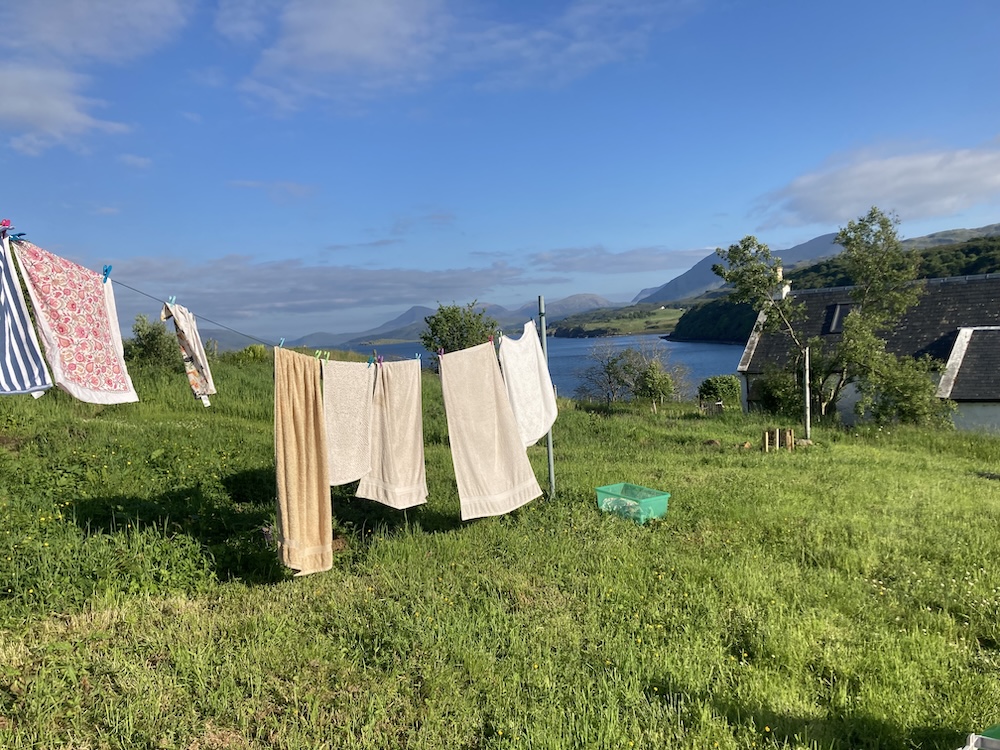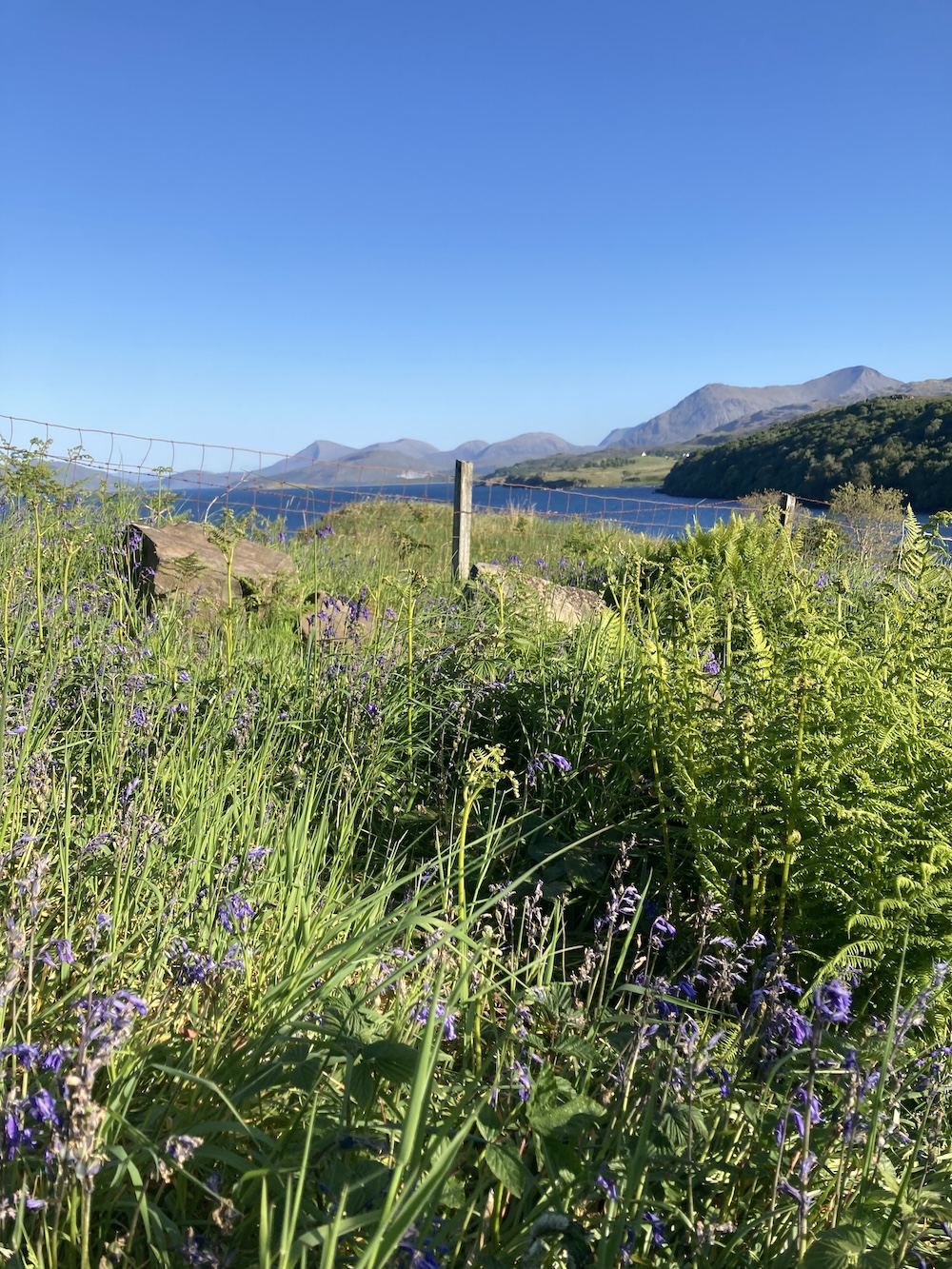An incomer to the Isle of Skye, Bethan Roberts looks beyond the romanticism to find complexity, interest and challenge.

You could be forgiven for thinking that Skye is all turquoise pools, faery-glow green, the Cuillin in mist and moody greys, across a spectrum of Instagram filters. Skye continues to be subject to a persistent romanticism. People variously come here to escape, to experience ‘wildness’, to find magic, or, more often than not, to tick off the five tourist hotspots. As a place to live, Skye is more complex, more interesting, and more challenging. It can be boring, beautiful, isolating, exciting, terrifying. There are issues facing the Gaelic language, of housing, tourism, childcare. Look beyond the Instagram filter and it’s the dark and traumatic history of the clearances that less romantically shrouds the misty isle.
I moved to Skye at the beginning of March, yet another clueless incomer. Still on the seasons and time of my old life, I didn’t yet know that this was the time of year when the hold of the long dark nights feels like it might finally be loosening, the sweet spot when cafés begin to reopen, yet the island isn’t too busy with tourists, so it’s still possible to get a nice coffee and have a bit of normal. It’s before the sudden greening of spring. Before the midges. Looking back now, I see how much I’ve become attuned to nature’s time, to Skye’s seasons and weather. As well as my experience of these things, living on Skye has changed my understanding of many others: wildness, remoteness, loneliness, belonging; my perception of light; my sense of geology and geography, and of my own identity. I hadn’t noticed the significance of the date on which I moved: the first of March, St David’s Day. For moving to this Celtic fringe, this Atlantic edge, has meant re-feeling into my Welshness. I experience, for the first time, the feeling of hiraeth, the untranslatable Welsh world close to homesickness, a spiritual longing for the land.
I watch the sea eagle — in many ways Skye’s bird — move through the sky over the bay. I’m sitting outside the cottage and it will never not be a shock and thrill to see and to live in such close proximity to this bird. It’s a slow and languid flight, a sort of heaving yet effortless glide, with an air of not-giving-a-fuck-ness that can only come with being the largest bird of prey. The eight-foot — eight foot! — wingspan casts an imaginary shadow across the bay and the bird seems all beak, hook and claw, flashes of yellow, its eye hooked into the whole universe. Yet the awfulness of the sea (or white-tailed) eagle belies its vulnerability and history. As much of the Highlands and Islands were transformed to sheep farming during the clearances, the bird’s predation of lambs meant it was persecuted to extinction. The final breeding pair on Skye in 1916 was also last in Britain, yet after their successful reintroduction in the region in the 1970s, the bird is doing well, and there are at least 16 pairs on Skye (where they’re posing problems to sheep farmers all over again). As well as taking lambs, I become intrigued by the Skye tale about how a sea eagle carried away a baby from one side of Portree loch to the other — the child became known as ‘Neil Eagle’, a name that stuck for the rest of his life.
When seeking to orient myself to a place, I often turn to what has been written about it — poetry as a compass of sorts. I’m drawn to the song-poems of the nineteenth-century Gaelic bardess Màiri Mhòr nan Òran (Big Mary of the Songs), especially her ‘Nuair Bha Mi Og’, ‘When I Was Young’ in which she looks back to her Skye childhood on a May morning, ‘the sun rising on Leac-an-Storr’:
Its rays engulfing the hillsides,
Hurrying away night’s dark clouds,
And above me sang the skylark,
Reminding me when I was young.
The title-refrain ends each verse (translation by Meg Bateman). The poem frequently moves from landscape features to close observation in a way that I find soothing: one moment Màiri’s climbing ‘Sithean’s shoulder’, yet her eyes are ‘on the beauty of every flower, / The dandelion and pale-yellow primrose, / The thistle royal and marigold’. The poem is underpinned by the Gaelic version of hireath, cianalas, written when Màiri had moved from the island. Yet, as well as looking back to her youth, the poem also looks back to a time before the clearances as she elegises places and a way of life Gaels have been forced to leave. It puts my own feelings of homesickness into embarrassed perspective. Often, in seeking to know this place through its poetry, it swims and drifts further from me. As well as its, to me, otherworld histories, reading Gaelic poetry and song in translation is already to be alienated from it, heightened by the fact that the language is so entwined with the natural world and place — one on which I’m trying to get a hold, to inhabit.

Music has saved me time and time again, and on Skye it’s Vashti Bunyan who comes to my rescue. Her 1970 album Just Another Diamond Day has long been a favourite, but living in the Hebrides, where much of it was written, I hear it anew. It brings me untold comfort and peace, and helps me to find a way to be on Skye. Many of its songs were written during or are about the journey by horse and cart Vashti made in 1968 to Skye: ‘Each hoof fall brings us nearer the land / Of peat and seabirds and silver sand’ as the words go to ‘Hebridean Sun’. She came in search of Donovan’s Waternish community of artists and musicians, but didn’t stay and carried on and settled on the island of Berneray. As well as the experience of moving in a similar northwards direction, it’s the delicacy, softness and gentleness — things I felt I’ve needed living here that the harsh landscape can’t give me — that leads me to listen again and again and to feel safe.
Our cottage looks out onto the gentle slopes of the red Cuillin, so called for the red glow that illuminates them with the low rays of sunset. But beyond that eyeline-horizon lies another: the jagged ridge of the black Cuillin. I’m glad I can’t see it from the cottage, all harsh spikes and tooths: the Gaelic An Culthionn might be from cuilionn — holly. Yet, move up a few feet behind the cottage and it’s suddenly in view. I see it driving home from the north, and from various unexpected points, with a jolt. Many people come to Skye in search of the wildness and remoteness it offers, and I feel myself moving in the opposite direction as I seek to make a home and to find security and connection here. It’s one of the ‘wild places’ that features in Robert Macfarlane’s book of that title. Yet, as Kathleen Jamie points out in her wonderful critique in the London Review of Books, there are different kinds of wildness that are to be found elsewhere: ‘not a place to stride over but a force requiring constant negotiation. A lifelong negotiation at that: to give birth is to be in a wild place.’
Indeed, the wildest night of my life begins in a car, driving through the night to give birth. The 3-hour drive to Raigmore hospital in Inverness is part and parcel of life here for islanders attending appointments outside the remit of Skye’s hospital and surgeries.
We set off at around midnight, along the windy, often single-track roads, mostly unlit by streetlamps. Into the early hours of the morning and off Skye, the roads become increasingly full of deer, slowing our progress. My contractions intensifying, I try not to panic as we drive along stretches of road I know to be signal-less, through bleak, deserted glens, headlights catching the eyes of deer. Mountains and hills loom by the side of the road. I’ve been taught in my pregnancy yoga class to breathe through each contraction visualised as a mountain, breathing up to its peak before exhaling the length down. I remember feeling this isn’t right, as I follow peak after peak through the darkness out the window — they’re not supposed to be real. At one point I’m convinced I’ll give birth by the side of the road. We arrive in Inverness as dawn is breaking: a strange, unworldly experience to drive through the lightening world into the fringe of the city from those dark unpeopled roads. Even stranger to enter the busyness of the hospital, the unreality of strip lights, the relief this brings. Yet, this journey of wildness has only just begun.
We emerge from the seasonless interior of hospital a few days later, with our newly coined daughter all plum-soft skin, sweet-warm breath and intense need. I stare down at her for the duration of the car journey home, back through those glens, at the wonder of her being, oblivious to the landscape. We take her back to our island home and the suddenness of Skye’s spring has happened while we’ve been away: the grass has shot up a foot, the bracken is high, softening the bleak grey flanks of the hills. The bluebells are out in full force and shine almost neon in the sun, or perhaps it’s my postpartum filter, and the cuckoo — a distant echo when we left — is now belting out from dawn to dusk right behind the cottage. Returning with a baby is like moving once more, the process of finding a way and a place and an identity begins all over again. Thankfully, my daughter is soothed by the lilting lullaby songs of Vashti Bunyan too. And I’m careful never to leave her unattended in the garden with those eagles about.
*
Bethan Roberts is a freelance writer, researcher, and editor living on the Isle of Skye who enjoys thinking and writing about nature, literature, music and film. She is the author of ‘Nightingale’ (Reaktion Books, 2021) and is currently working on her third book, about life on the Isle of Skye.